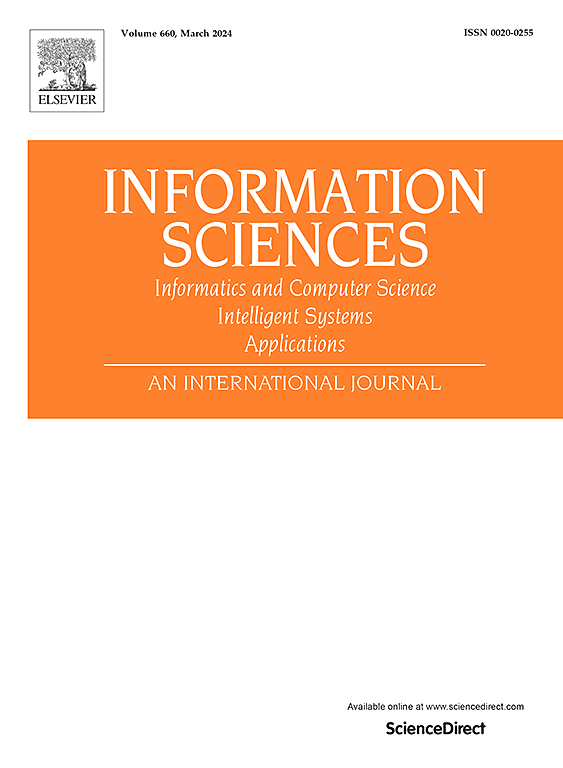一种基于字典学习的多视图正向正无标记图学习方法
IF 8.1
1区 计算机科学
0 COMPUTER SCIENCE, INFORMATION SYSTEMS
引用次数: 0
摘要
随着复杂现实场景中对图数据分析需求的不断增加,由于数据的稀缺性,单纯依赖标记的正/负样本的传统图分类方法面临着很大的局限性。为了解决这一挑战,我们提出了一种新的基于字典学习的多视图正标记图学习框架(MVPU-DL)。我们的方法通过三个关键机制创新地利用未标记图作为特权信息:1)具有跨视图一致性约束的多视图字典学习范式,该范式使用分析字典生成判别稀疏代码;2)一种新颖的PU-SVM分类器架构,该架构集成了特定于视图的字典,能够从有限的正样本中实现鲁棒的特征表示;3)一种可证明收敛性的交替凸优化策略,用于联合学习判别字典和分类边界。在跨越不同领域的12个基准数据集上进行了广泛的实验-包括生物化合物(PTC, MUTAG),化学相互作用(COX2, DHFR)和社交网络(Twitter, DBLP) -验证了MVPU-DL的优越性能。所提出的跨视图字典对齐策略在不同标记比率下特别有效,与最先进的基线相比,平均f1分数提高了2.16%(最大提高了3.88%)。结果表明,MVPU-DL算法的性能优于其他算法。本文章由计算机程序翻译,如有差异,请以英文原文为准。
A multi-view forward positive and unlabeled graph learning method based on dictionary learning
With the increasing demand for graph data analysis in complex real-world scenarios, traditional graph classification methods that rely solely on labeled positive/negative samples face significant limitations due to data scarcity. To address this challenge, we propose a novel multi-view positive and unlabeled graph learning framework based on dictionary learning (MVPU-DL). Our approach innovatively utilizes unlabeled graphs as privileged information through three key mechanisms: 1) a multi-view dictionary learning paradigm with cross-view consistency constraints, which uses analytical dictionaries to generate discriminative sparse codes; 2) a novel PU-SVM classifier architecture that integrates view-specific dictionaries to enable robust feature representation from limited positive samples; 3) an alternating convex optimization strategy with provable convergence for jointly learning discriminative dictionaries and classification boundaries. Extensive experiments on 12 benchmark datasets spanning diverse domains—including biological compounds (PTC, MUTAG), chemical interactions (COX2, DHFR), and social networks (Twitter, DBLP)—validate the superior performance of MVPU-DL. The proposed cross-view dictionary alignment strategy is particularly effective under varying labeling ratios, achieving a significant average F1-score improvement of 2.16% (with a maximum improvement of 3.88%) compared to state-of-the-art baselines. These results demonstrate that MVPU-DL outperforms other methods with remarkable performance.
求助全文
通过发布文献求助,成功后即可免费获取论文全文。
去求助
来源期刊

Information Sciences
工程技术-计算机:信息系统
CiteScore
14.00
自引率
17.30%
发文量
1322
审稿时长
10.4 months
期刊介绍:
Informatics and Computer Science Intelligent Systems Applications is an esteemed international journal that focuses on publishing original and creative research findings in the field of information sciences. We also feature a limited number of timely tutorial and surveying contributions.
Our journal aims to cater to a diverse audience, including researchers, developers, managers, strategic planners, graduate students, and anyone interested in staying up-to-date with cutting-edge research in information science, knowledge engineering, and intelligent systems. While readers are expected to share a common interest in information science, they come from varying backgrounds such as engineering, mathematics, statistics, physics, computer science, cell biology, molecular biology, management science, cognitive science, neurobiology, behavioral sciences, and biochemistry.
 求助内容:
求助内容: 应助结果提醒方式:
应助结果提醒方式:


